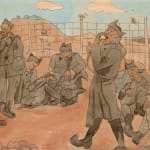Gregoire Michonze 1902-1982
Further images
Michonze drew directly on his own experiences in this small but powerful watercolour. After enlisting in the French artillery in 1939, he had been taken prisoner in June 1940 and transferred to Stalag XC at Nienburg-on-Weser, 60 km from Bremen in Germany, until his release in December 1942. Stalag XC housed Prisoners of War (POWs) - ranks below commissioned officers, non-commissioned officers and enlisted men - initially French soldiers, but later Polish, Belgian, Romanian and Serbians were also sent there. In late 1943, following the armistice, they were joined by the Italians. There were also Soviet POWs, who were housed in the easternmost hut, isolated from the others by an additional barbed-wire fence. Held in conditions of great overcrowding, they were also differently treated according to their nationality and status. The Russian prisoners of the Red Army were held in the worst conditions and received the worst treatment: denied POW status, outside food parcels and access to international observers, many died from ill treatment, starvation and disease. Michonze witnessed their sufferings, recording them in other drawings (some later worked up into paintings), and remained haunted by their memory.
The exhausted prisoners shown here however, have been identified by their uniforms, especially their distinctive double peaked caps, as Polish soldiers. Depicted surrounded by barbed wire and guarded by an armed sentry, they huddle in their uniforms in small groups, talking, resting fitfully on the ground or gnawing hungrily at potatoes, while two birds resting lightly on the fence point to the possibility of freedom. Although more realistic than many of Michonze's works, this work shares with them a surreal, naive and allegorical quality.



